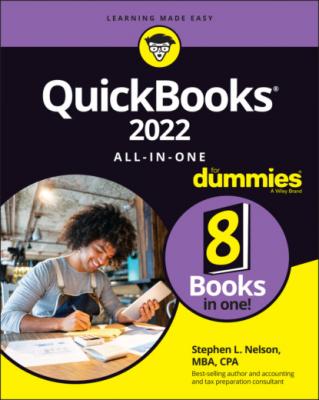QuickBooks 2022 All-in-One For Dummies. Stephen L. Nelson
Чтение книги онлайн.
Читать онлайн книгу QuickBooks 2022 All-in-One For Dummies - Stephen L. Nelson страница 36

| Account | Debit | Credit |
|---|---|---|
| Loan interest expense | $1,200 | |
| Loan interest payable | $1,200 |
When the actual loan interest payment is made, the journal entry appears as though no accrual or reversal ever existed, as Table 3-18 shows. Suppose that at some time in year 2, the business pays $1,800 in interest by making a cash payment. Journal Entry 18 shows how this transaction gets recorded.
TABLE 3-18 Journal Entry 18: The “Real” Loan Interest Payment
| Account | Debit | Credit |
|---|---|---|
| Loan interest expense | $1,800 | |
| Cash | $1,800 |
Let me quickly summarize what happens with journal entries 16, 17, and 18:
Journal Entry 16 enables you to show that at the end of year 1, the business owes $1,200 of interest on a loan — even though that interest hasn’t yet been paid. Journal Entry 16 also shows that even though the money wasn’t paid, loan interest expense of $1,200 was incurred.
Journal entries 17 and 18 need to be combined to be understood. Journal Entry 17, for example, reduces the loan interest payable to zero. Remember that the loan interest payable would be a balance sheet liability account. The combination of the $1,200 debit and credit zero this account out. The $1,200 credit to loan interest expense in Journal Entry 17 must be combined with the $1,800 debit to loan interest expense in Journal Entry 18. This seems funny, because after all, aren’t you really paying $1,800 of interest? That’s true. But looking back at Journal Entry 16, you can see that you’ve already recorded $1,200 of loan interest expense. That interest expense has been recorded for year 1 in this example. If you have $1,800 of loan interest in total, what’s left over for year 2 is the remaining $600. The combination of the $1,200 credit to loan interest expense and the $1,800 debit to loan interest expense produces this $600 of loan interest expense. The only other component of these two journal entries is the $1,800 credit to cash. This credit to cash represents just the actual cash payment that’s made to pay the loan interest amount.
You need to be careful when working with accrual entries, reversing entries, and then the real entries that follow and correct everything in the end. These tools can be enormously helpful when it’s important to measure expenses and liabilities accurately. You must remember to complete the entire sequence of transactions, however; you can’t stop halfway.
One last important point: In journal entries 16, 17, and 18, I talk about how to accrue loan interest expense. You can use this accrual technique to recognize any liability — a fact that I want to emphasize. You can use the technique demonstrated in these journal entries to deal with liabilities for things such as wages owed to employees, taxes owed to the government, and so forth.
Some firms, particularly those with sophisticated accounting systems, can even use this technique to record hard-to-quantify liabilities, such as warranty liabilities. (A warranty is a promise that you make to a customer. You might promise that your product won’t break, for example.) These promises create liabilities and expenses. An accurate accounting system requires that you record these expenses as they occur and recognize these liabilities as they come into existence.
Closing Out Revenue and Expense Accounts
You’re about to enter the twilight zone of accounting. In this section, I talk about what happens to revenue and expense accounts at the end of the year in traditional manual accounting systems. Then I explain why QuickBooks doesn’t quite work that way and what you need to do about it.
If you want to skip anything in this chapter, this section may be that material. On the other hand, if you (like me) have a compulsive personality and deem it essential to read everything in this chapter (even stuff that’s not particularly exciting), read on.
Book 1, Chapter 1 and Book 1, Chapter 2 describe an imaginary hot dog stand, a one-day business that (in my imagination) you operate. (If you’ve been reading this chapter and have no questions, you don’t even need to worry about the two preceding chapters.) Table 3-19 shows the trial balance for this business at the end of the day of operation.
TABLE 3-19 A Trial Balance at the End of the Period
| Account | Debit | Credit |
|---|---|---|
| Cash | $5,000 | |
| Inventory | 0 | |
| Accounts payable | $0 | |
| Loan payable | 0 | |
| S. Nelson, capital | 1,000 | |
| Sales revenue | 13,000 | |
| Cost of goods sold | 3,000 | |
| Rent | 1,000 | |
| Wages expense | 4,000 | |
| Supplies | 1,000 | _____ |
| Totals | $14,000 | $14,000 |
The traditional close
As I hope you already know, revenue and expense accounts count revenue and expenses for a particular period of time. Revenue and expense accounts may count for the month, the quarter, or the year, for example.
One thing that accounting systems traditionally do is zero out the revenue and expense accounts at the end of the year. This